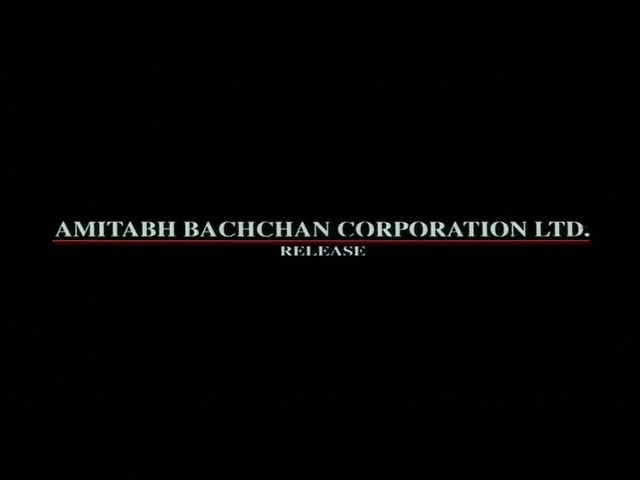
The Big B's seal of approval.
Bombay, Mani Ratnam's 1995 film that deals with the 1992 and 1993 Hindu-Muslim riots of Bombay, is much like Mani Ratnam's other film, the PPCC favorite, Dil Se. Both films explore timely and provocative subjects: communal violence in one, terrorism in the other. Both films have beautiful cinematography with music by A.R. Rahman. Both feature Nepalese actress Manisha Koirala. Children are omnipresent and clearly loved. In both cases, the hero is smitten by the heroine within the first ten minutes; by the first half hour, the protagonists in Bombay are already assuring each other that they'll never, ever leave each other. Hey, fast movers!
The song Tu Hi Re, wherein our unlikely romantic hero sobs while waves crash and it slowly dawns on the PPCC that this film is not in Hindi.
But of course the point of Bombay is not the love story, it's the riots. Hence director Ratnam hurries us through the love story of the first act (somewhat clumsily, the PPCC thought) to get us out of the village and into the tense, sweltering city. For those who don't know what really happened, Suketu Mehta's Maximum City is an excellent source (and a very good book as well). Otherwise, Wikipedia can suffice. The film is blunt in its message: communal violence is senseless, more often than not the innocent man suffers. Not only do the characters in the film just plainly say these things (or, typically, scream them through their tears), but they themselves are also symbolic of the larger Bombay community.

Shekhar wiggles his way into Shailo Bano's heart using the old, I-disguise-myself-as-you technique.
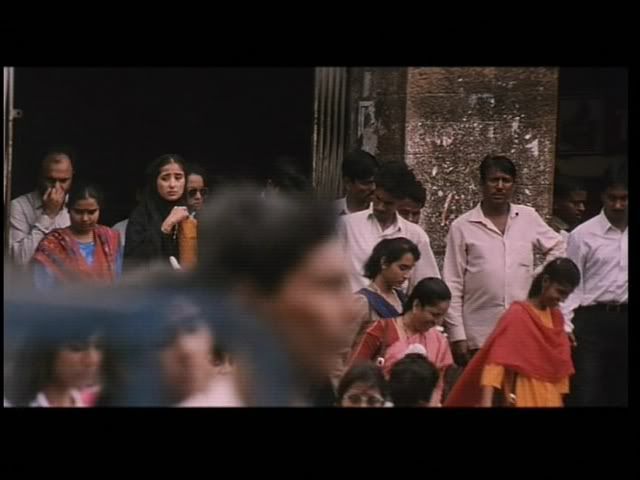
Big, scary city!

The angry fathers.
Shekhar (Arvind Swamy) is Hindu. He is young and educated and has a job working in the newspaper in Bombay. Despite his provincial family's misgivings, he has no interest in an arranged marriage and intends to leave the village for Bombay permanently. One day, he spots Shaila Bano(Manisha Koirala) a Muslim girl, just as her black veil is lifted by the wind, momentarily revealing her face. This glimpse is enough: Shekhar is in love. He pursues her and she, although intensely modest and obviously anxious at the religious divide, eventually admits that she loves him too. Fast? No matter, we're still not in Bombay and the film is called Bombay. And fear not, the relationship's realism improves as the film progresses.
When Shekhar informs Shaila Bano's father that he intends to marry her, Shaila Bano's father informs Shekhar that he intends to hack him to pieces with his machete first. When Shekhar informs his own father that he intends to marry her, his own father proclaims, "Over my dead body!" Interestingly, the fathers are mirrors of each other: they wear their religion in obvious and explicit ways, and they both guilt trip their children with the same logic: "I prayed so hard to Lord Ram/Allah for you, why are you being so lame to me now?!" (Well, the PPCC paraphrases.)
So Shekhar and Shaila Bano elope. After a speedy wedding which comprises of getting the marriage certificate stamped, they move into a humble sublet in the heart of Bombay. Although Shaila Bano is inhibited and country bumpkin to the Nth degree, their marriage slowly warms and becomes happy. Indeed, the two are a joy to watch, with much cuddly affection and gentle teasing. Eventually, Shaila Bano is pregnant: this news enough sends the two fathers-in-law back in the village into a tizzy. They start arguing over how their grandchild will be raised, Hindu or Muslim, but it's clear that some of their own tension is melting. At least, Shaila Bano's father has stopped waving that machete.
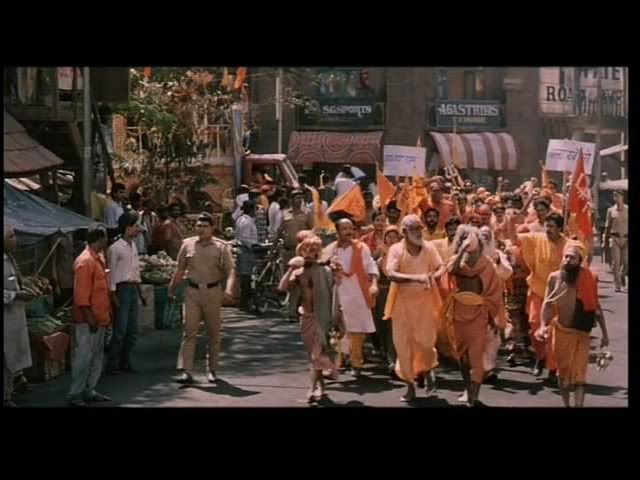
Things start to degenerate.
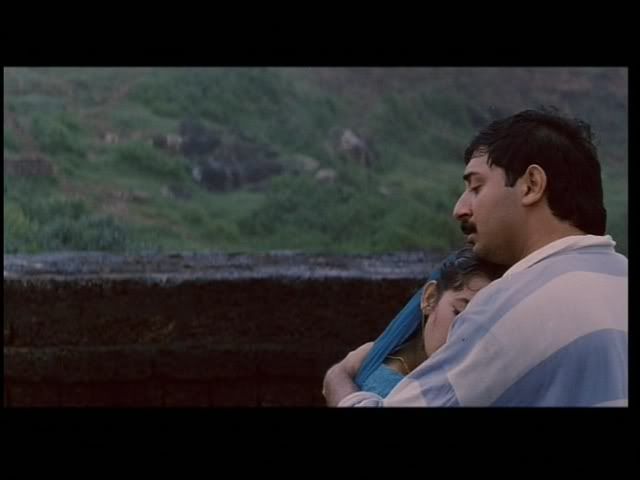
Golden ratio!
Unsurprisingly, two twin sons are born. We say unsurprising because, regardless of religion, sons are highly valued in India. And the twins, Kamal and Kabir, clearly represent the two religious identities of the country. Indeed, once the rioting starts, it's the twins in danger and the twins getting separated which parallel the various uprisings of communal violence. Once the twins, scratched and bleeding and exhausted, one wearing a kurta pyjama and another in Westernized t-shirt and shorts, find each other among the wreckage and smile, we know that all shall be well. In fact, it's that highly symbolic ending that bothered the PPCC - it seemed facile, dropping all the weight from a film which had worked so hard to be brutal and honest in its treatment of a difficult subject.
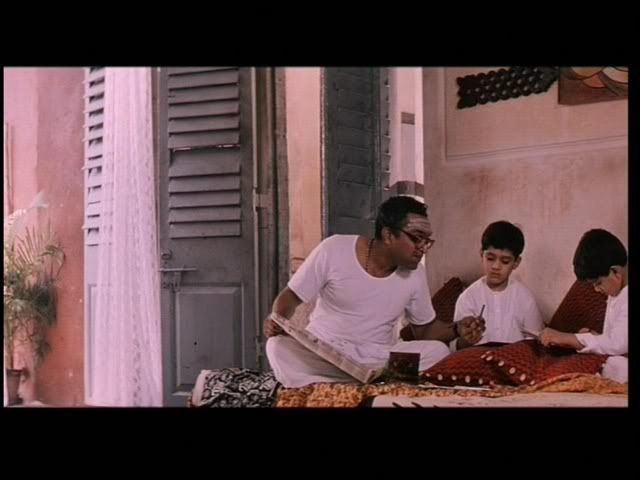
Grandfather and grandsons. Awww!
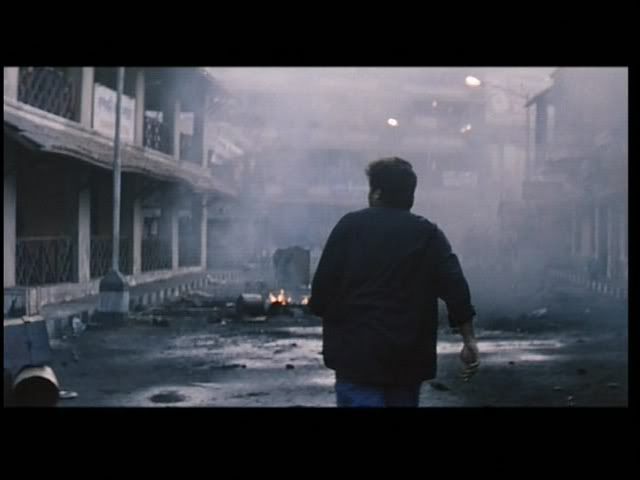
After the destruction.
The genius of Mani Ratnam is that, as preachy and obvious as the film becomes in its message of peace, the story of a broken, suffering family remains always in the forefront; this gives the audience an easy hook and keeps things, well, emotionally manipulative, but also very human rather than political. We have only glimpses of the leaders behind the mobs, and the violence is always portrayed as chaotic, incomprehensible, and something that starts in the background but then swells up to involve the protagonists as well. Obviously, the film remains very vague and noncommittal in its actual treatment of blame: if anyone's to blame, it's the politicians, though no names or parties are specified. The subject being as sensitive as it is, the PPCC also watched carefully to see if any of the characters, Hindu or Muslim, were favored by the narrative. We noticed that the Hindu father-in-law seemed slightly favored: he didn't wield any cane knives, he was the first to arrive in Bombay and reconcile with the couple, and he risks his life to save his in-laws' Qur'an. Similarly, Shekhar, a Hindu, takes action and, by sheer force of personality and an appeal to the rioters' humanity, manages to stop the violence in his neighborhood. Shaila Bano remains passive in this sense; but this is more likely a reflection of gender roles. The Muslim father-in-law seems to fulfill the stereotype of the "violent" Muslim that the Hindu father-in-law warns his son about early on, but he does get the redeeming scene of saving the other father-in-law and one of the twins from a mob, making the first step to call his fellow father-in-law bhai.
Actually, picking it apart like this is probably unhealthy. It certainly goes against the point of the film: we are all Indian brothers, no side is more guilty than the other, and giving in to communal hatred is just pandering to the politicians, who foment these things for political reasons*. Suffice to say that, even when we found the storytelling too blunt, it still moved us to tears, again and again. Some of the scenes are so awful that they are difficult to watch, and, while the violence is not very graphic by Hollywood standards, it is still disturbing. The entire family - Shekhar, Shaila Bano, the twins, the in-laws - are very sympathetic characters, and when, in the second half, they are all in ceaseless peril, we at the PPCC were in ceaseless anxiety. The PPCC's favorites were probably the two fathers-in-law. Their initial relationship, which is boiling-hot tense, eventually melts away into more and more acceptance, and this was a joy to watch.
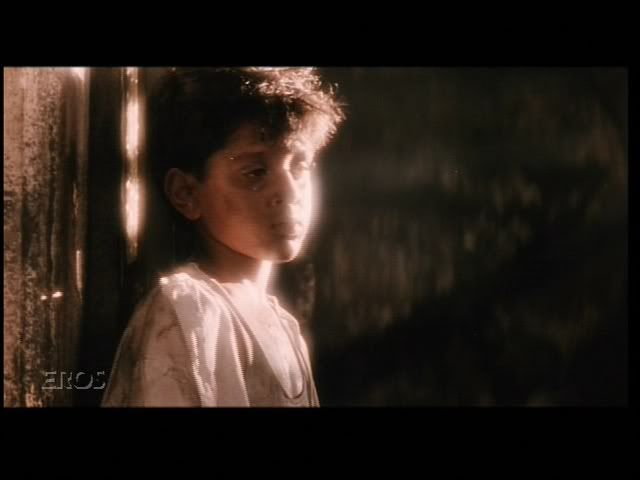
One of the twins. Note the holy light; kids are always cherub-ified in Mani Ratnam movies.
Considering the cinematography, the film is crafted very well. While Ratnam's timing seemed a little rushed and clumsy (e.g. fast cuts of brooding establishing shots), his colors and his composition were consistently beautiful. Also, while we did not enjoy the songs very much (surprising, considering how good A.R. Rahman is!), the choreography was always visually impressive. The PPCC's favorite song was definitely the Let's Have a Baby Girl! song, which was surreal and Hook-esque and fun. There were some wonderful moments of visual storytelling, many of which have already been mentioned in Filmi Geek's review): Shaila Bano's burqa getting caught in a branch and abandoned there as she goes to meet her lover, one of the twins wiping away the Hindu paint on his grandfather's forehead as Muslim goons loom near, the contrasting Hindu and Muslim crowds at prayer, the mob leaders arriving on the scene after the destruction and being appalled by it.
As Shekhar, Arvind Swamy improved dramatically as the film progressed. In the beginning, the PPCC was asking itself how this plain, moustached guy could ever be convincing as a romantic lead. He wasn't, really, though he became very convincing as a concerned father and husband. Manisha Koirala was somewhat irritating, in that we did not like her characters' infantile modesties and inhibitions - of course, Manisha is less to blame as much as a woman's life in a sheltered, patriarchal society is to blame. The PPCC shudders to think it, but probably if we had been raised in some village, entirely domesticated and trained only for our marriage, we would probably come out much the same. (And yes, the PPCC is still reading Betty Friedan's The Feminine Mystique, which talks just about this.) Both actors playing the fathers were excellent, as we mentioned above. The child actors playing the twins were tolerable; we've seen much better (Christian Bale, Empire of the Sun) and much worse (that awful daughter from Mukti). It was interesting to recognize Tinnu Anand as the right-wing Hindu mob leader; why, just the other day the PPCC went to see Laagaa Chunari Mein Daag, and we commented on how wonderfully effective he is as a villain, what with those teeth and that Forrest Whitaker-esque lazy eye. It was too bad we couldn't have seen more of him being evil. A very interesting character that appears without any explanation or prologue is the transvestite who helps one of the twins during their separation and teaches us about religious pluralism. Who was that guy?!
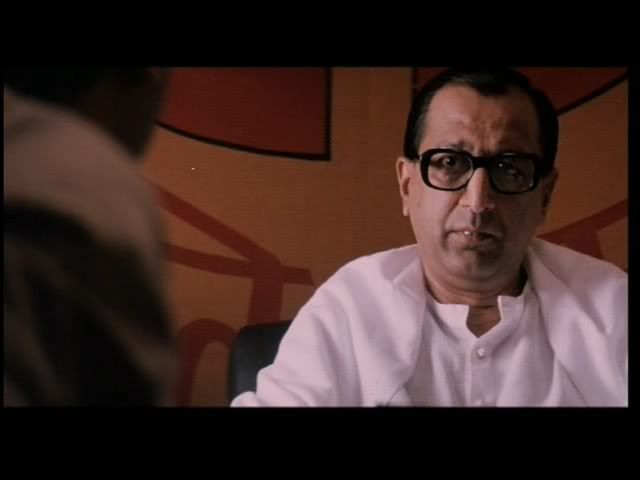
Wonderful Tinnu Anand as the scary Hindu leader. You can get more Tinnu in In Custody and China Gate.
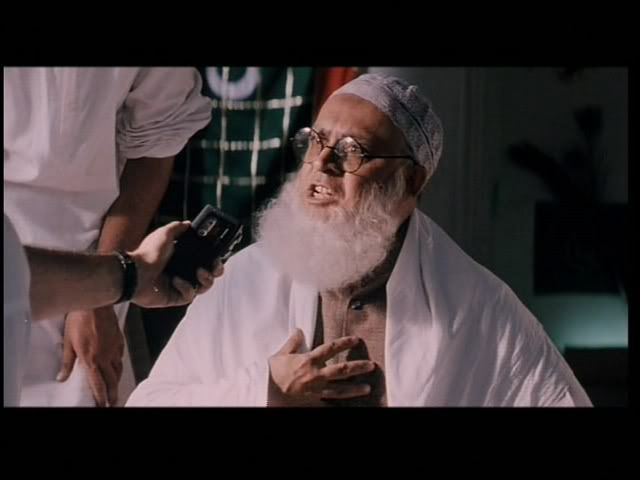
The Muslim leader similarly waxing prejudicial.
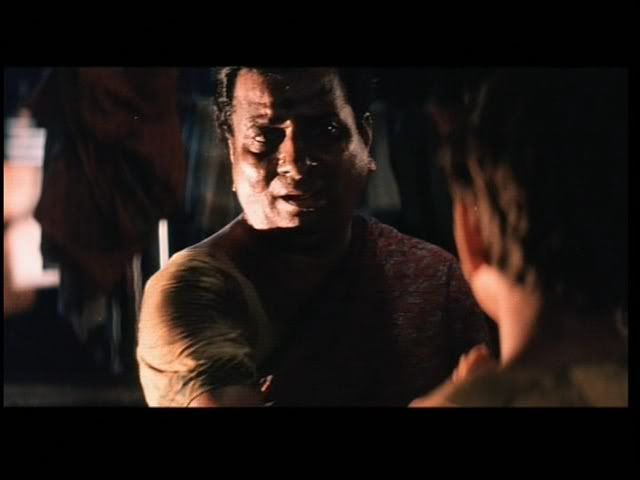
The fascinating and sympathetic transvestite guy! Someone make a movie about this guy.
A note about the languages: the PPCC realized only belatedly that this film is actually originally in Tamil with Hindi dubbing and English subtitles. In the beginning, we were a bit distracted by the constant lip-syncing not actually being in sync, but one gets used to it.
*See the first essay for more!
More Reading
To supplement our review, with its paltry film analytics, we have gathered some further reading materials which might prove to be more stimulating.
- The Illusion of Secularism: Mani Ratnam's Bombay and The Consolidation of Hindu Hegemony, Angie Mallhi. University of Vancouver, 2005. An interesting look at how Bombay might be a bit more pro-Hindu than its superficially pluralist (Mallhi says "secularist") message seems. She notes the differences in how the fathers are presented.
- Mani's Magic. Some gushing about Mani Ratnam's particular brand of cinematography combined with A.R. Rahman's particular brand of background music which, yes, can be pretty damn effective.


2 comments:
good site ,i good the link while i was searching for reviews of kalyug ,now it seems there is much more than that here :)
Hi, just found your blog via awesome tumblr recommendations. You should check out Mani Ratnam's Kannathil Muthamittal which has a very different kind of child in it: definitely not a cherub but still lovable. I'd also recommend Geethanjali... those don't seem to get as much attention as Dil Se or Bombay, but they're some of my favorites by him. They have independent and vibrant heroines and great personal dynamics and music.
Also, love the blog. These are some of my favorite reviews of Indian films so far... and your links to other reviews are always helpful, too.
Post a Comment